- 紙布 -
紙の製法は5世紀頃に中国から伝わった。紙は使われた後も捨てる事はせず、 細く切って紙縒りにして横糸に織り込んで、再利用された。

Category
- Shi-fu -
Paper
Paper-making was introduced to Japan from China around the 5th century. Used paper would be not discarded. It would be recycled by shredding, spinning and weaving, to be used as weft material.
Paper
Paper-making was introduced to Japan from China around the 5th century. Used paper would be not discarded. It would be recycled by shredding, spinning and weaving, to be used as weft material.

おおつづれ
たて糸:藤 よこ糸:藤糸に反故紙を巻いた糸使用
a weft made from spun recycled paper thread which was wrapped around wisteria thread.
たて糸:藤 よこ糸:藤糸に反故紙を巻いた糸使用
a weft made from spun recycled paper thread which was wrapped around wisteria thread.

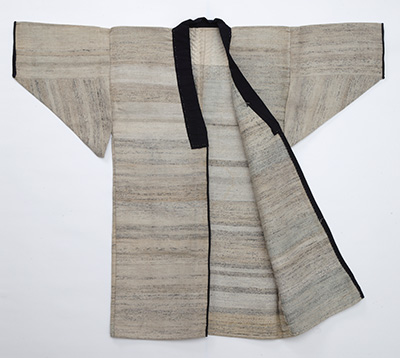
「おおつづれ」
たて糸は藤糸。よこ糸に、藤糸に反故紙を細かく切って紙縒りにした糸を巻き 付けた糸を使っている。
仕事着の性格上、藤の強さと紙の柔らかさと暖かさを求めた結果であろうか。 新潟県と山形県の山間部あたりで作られ、山形県の庄内地方で売られていた。
明治、大正時代
OTSUZURE Work wear
Although very rare, some work clothes such as otsuzure, are woven with a weft made from spun recycled paper thread which was wrapped around wisteria thread. The warp used in these work clothes are made from wisteria thread. This garment is an example of an otsuzure. Did the conditions in those days influence people to combine the strength of wisteria thread and the softness and warmth of spun paper thread for their work clothes?
Otsuzure was made in the mountainous border area between Niigata and Yamagata prefectures and was sold in the Shonai area of Yamagata.
Meiji - Taisho period (1868-1926)
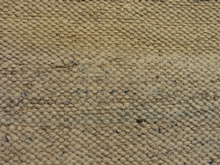
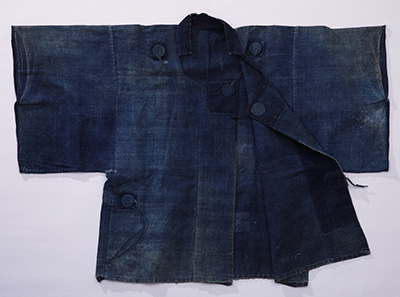
「道行」
形から推測して江戸時代の武士や町人の男性の旅装束。織った後に藍で染めて いる。擦れた表情がジーンズのとそっくりで、時代も国境も越えている。
江戸時代
Michiyuki Traveling coat According to the shape of the travel outfit, it was most likely worn by a samurai or a townsman during the Edo period. It was dyed in indigo after being woven. The worn-out characteristics of this outfit are very similar to a pair of modern distressed jeans. This similarity in appearance is a visual bridge between textiles of two different eras and two far- flung places.
Edo period
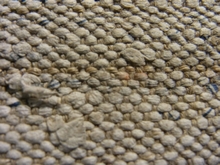
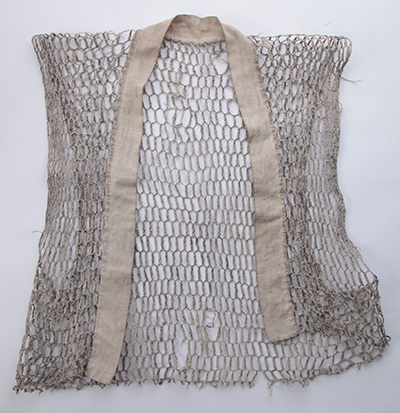
「汗はじき」
反故紙を紙縒りにして、編んだ夏用の半襦袢。編むことで、着物との間に隙間 が出来、べたつかずに快適であったのであろうか?
産地等詳しい事は、わ かっていない。中国、韓国にも似たような物がある。
Asehajiki Sweat under garment
Ase-hajiki Han-juban is a short under-kimono, worn similar to an undershirt in western clothing, to keep the interior of the kimono from being soiled. Ase-hajiki literally means to repel sweat. “Ase” in Ase-hajiki means sweat and “hajiki” means repel. It is unknown where this type of undergarment first originated as similar clothing were found in China and Korea.
This Ase-hajiki Han-juban is made of tightly braided recycled paper threads.
Was this undergarment comfortable to wear beca use the gaps in the tightly braided cloth prevent sweat from sticking to the skin?
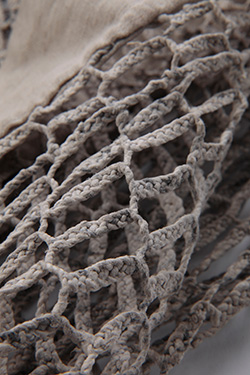
Copyright 2002 Gallery Kei. All rights reserved.
